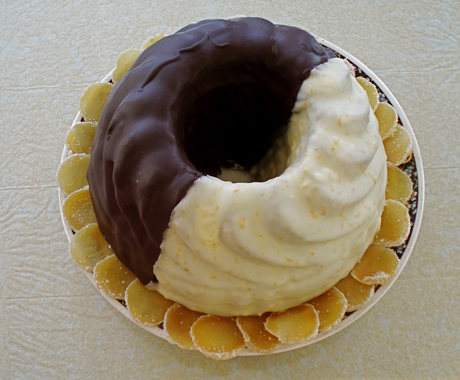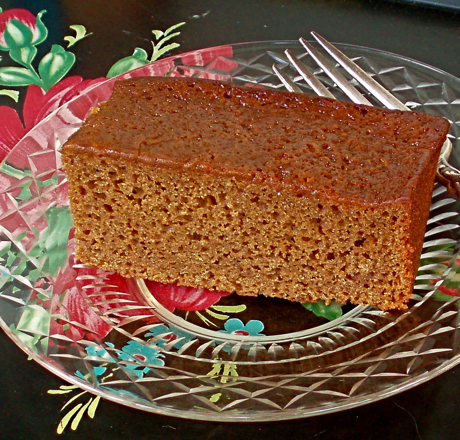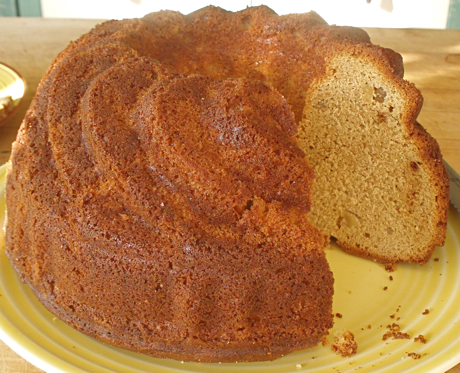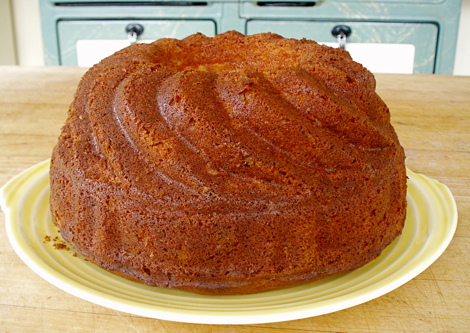Triple Ginger Gingerbread – and the paths down which it led
Actually, Triple Ginger was the first stop on a path that started with a yen for old fashioned hot water gingerbread: soft, spicy, homely, simple to make – the original brownie, if by “brownie” you mean a rich dark snack cake to eat out of hand. (The chocolate kind is a cake-come-lately compared to gingerbread.)
I don’t make gingerbread very often, and thus felt in need of a reminder recipe. But instead of consulting any of several dozen cookbooks or, of course, the net, I made the mistake of trolling about in my own published works, where I stumbled on
something I had not made in a great many years. Fresh ginger, candied ginger and the spice kind in concert, it sounded so enticing I made one. The finished cake seemed very tasty to me, but Bill didn’t think it was sweet enough. So I made another one, with a little more sugar, and then for good measure put icing on it and while I was at it used two flavors of icing, for taste trial purposes.

Dark and white chocolate ganache icings on Triple Ginger Gingerbread (the white one has orange peel in it).
These are not small cakes and there are just the two of us, so at this point there’s quite a bit of gingerbread around. Sharing takes place. Opinions of tasters are divided on the better icing question and meanwhile I’m still wanting some old fashioned gingerbread, which this one does not resemble in the slightest.
OK, no problem. I do have a recipe for Hot Water Gingerbread*. I just got sidetracked, is all. So I made a batch.

The fork is because I couldn’t find Bill to hold a piece in his hand, a hand being the correct implement for eating this kind of gingerbread (at least if there isn’t a lot of whipped cream involved).
Very good – in fact pretty much just what I was craving in the first place. But now for some reason I was on the trail, wanting to see what else was out there, starting not very far out there (in my own library).
At first glance it looked like there would be a lot; up until roughly the Second World War, cookbooks routinely gave gingerbread its own separate chapter. This was never a large chapter, but it did make clear that gingerbread warranted a certain respect.
Unfortunately, it didn’t seem to warrant much in the way of imagination. Ingredients and methods stayed pretty much the same from recipe to recipe, until I got to Lowney’s Cookbook (1907), where there is a recipe for New York Gingerbread*.
New York! Gotta try it, even though there’s no molasses in it and it looks suspiciously like it’s going to be pound cake. Sure enough, pound cake, more or less, in spite of containing a full tablespoon of “yellow ginger.” What’s up with that?
Back to the books, just on a whim starting with my encyclopedic 1961 Larousse Gastronomique, a translation of the first (1938) edition. Not too surprisingly, there is no mention of any gingerbread at all.
Ginger itself gets only a short paragraph, but on the way there I found thirteen recipes for turkey giblets. Never never never am I getting rid of this book, cumbersome though it may be at well over five pounds.
Maybe a later version? The 1984 edition has reduced the giblet recipes to a mere seven, just one of them specifically for turkey giblets, and now there is a lengthy entry for “Gingerbread.” But the Larousse, being French, devotes the entry to pain d’epice. There is no mention of either molasses or New York.
Maybe something older and American? Perhaps The Cook’s Own Book, Being a Complete Culinary Encyclopedia, by a Boston Housekeeper (Mrs. N.K. M. Lee), 1832. Here too, giblets come right before gingerbread. A single recipe for giblets, then six for Gingerbread, four for “Gingerbread Nuts” and one for Ginger Cakes. Inconveniently for my research, every blessed one of them produces something hard and durable, much closer to cookies than cake, presumably because hard gingerbread has been around for centuries longer than the cakey kind.
Being cribbed from English cookbooks, all the recipes call for treacle, rather than molasses. Nothing about New York. On the good side, right after Ginger Cakes comes Ginger Imitation, made from lettuce stems. Who knew?
Whim still weighing almost as heavily as the book collection, I tried The Overseas Press Club Cookbook (1962). Maybe some homesick reporter has something interesting to say. Again, again not surprisingly, no. But you’d never find Hermann Goring while looking for gingerbread if all you used was the net.
The net having its virtues, however, I googled “New York Gingerbread” and was rewarded with a major happy find: David Walbert, a discursive polymath in love with culinary history who’s writing – among other things – a book about American baking (called “tentatively” The Decline and Fall of Gingerbread) and in the process sharing vast quantities of fascinating arcana.
Included in same is a recipe for New York Gingerbread from 1871. It’s not too much like the one in Lowney’s but does share the absence of molasses and the presence of the tablespoon of yellow ginger.
Figuring I’d probably found the motherlode, I wrote to Mr. Walbert, inquiring. He too has wondered about the New York part without coming across any definitive explanation. What he does know is that there are many recipes for New York Gingerbread (starting in the 1850s) that do contain molasses, so whatever makes the stuff “New York,” being molasses-free aint it.
Back to the bookcase, and why I didn’t think of Fannie Farmer earlier I cannot tell you.
New York Gingerbread isn’t among the numerous gingerbreads in either of the editions I happen to have at hand (1924 and 1936), but it IS in the books, under cake. In 1924, you make NYGB – exactly the same recipe as Lowney’s, those of you who follow these things won’t be surprised to hear – and if you want to make Newport Pound Cake you just omit the ginger.
In the revised, 1936 Fannie, where “changes have been made to conform with modern fashions in food,” you can see gingerbread losing status before your very eyes. The recipe is still the same, but now it’s for Newport Pound Cake and NYGB is the variation. So another locale raises its head, without clarifying things in the least.
Anyone who can shed light on these geographical mysteries is encouraged – nay, begged – to write in. Meanwhile, back at the stove, I’m thinking it would be good to find a gingerbread that tasted old fashioned but shared the great advantage of brownie-making: melting the butter instead of creaming it.
First one that came to light (which turned out to be fine, so enough already) was the Appleyard Center Gingerbread* in Mrs. Appleyard’s Family Kitchen, by Louise Andrews Kent, aka Mrs. Appleyard, and her granddaughter, Polly Kent Campion, 1977. It neatly brings us home to New England, having been published by Vermont Life Magazine, where Mrs. Appleyard held forth from 1962 until her death in 1969.
As I was at this point no longer having much of a yen for plain old fashioned gingerbread, I used the batter to make not only a pan of the usual but also some madeleines and some cupcakes with black walnuts in them. Like melted butter brownies, they all came out of the oven with a very thin, crisp top layer. Big hit (especially the madeleines).
I did try making an icing for the cupcakes, using cream cheese, sour cream and some double (black and red) raspberry jam. Not bad, but given that somewhat later Bill asked “ what’s that purple pudding in the icebox?” I don’t feel it has a future.
TRIPLE GINGER GINGERBREAD
- 2 tbl. peeled fresh ginger, shredded on the 1/8th inch holes of the grater
- 2 tbl. triple sec or other orange liqueur
- 2 1/4 c. cake flour
- 1 tsp. each baking powder and ground ginger
- 1/2 tsp. each ground cardamom and baking soda
- 1/4 tsp. salt
- 1/2 c. butter
- 1 c. tightly packed dark brown sugar
- 2 eggs
- 1 c. buttermilk
- 1/3 c. candied ginger, cut into very small dice
1. Combine the shredded ginger with the triple sec and set aside. Heat the oven to 350°F. Generously butter a 1 1/2 quart bundt pan and set aside.
2. Stir or sift the dry ingredients until thoroughly combined. Set aside. In a large bowl, cream butter with brown sugar until light and fluffy (takes a while), then beat in the eggs.
3. Add buttermilk alternately in thirds with the flour mixture, beating well after each addition, then stir in the candied ginger and the shredded ginger mixture.
4. Turn the batter into the prepared pan, bang down sharply to release big air bubbles and bake until the cake shrinks from the sides and a toothpick comes out clean, anywhere from 45 minutes to a bit more than an hour, depending on pan and oven (overbaked is better than underbaked).
Turn out and cool on a wire rack. The plain cake keeps well, tightly wrapped, for a week or more.
OLD FASHIONED HOT WATER GINGERBREAD
I have no idea where I got this recipe. Also no idea why it calls for largish amounts of both soda – the traditional leavener – and baking powder (overkill that probably has David Walbert shrieking all the way down there in North Carolina). But it always works and always tastes good so I’m not going to mess with it.
- 2 c. all purpose flour
- 2 1/2 tsp. ginger
- 2 tsp. cinnamon
- 1 ½ tsp. baking powder
- 1/2 tsp. each salt and mace
- 6 tablespoons lard or chicken fat OR 1/2 c. butter
- 1/2 c. firmly packed dark brown sugar
- 2 eggs
- 3/4 c. molasses
- 1 cup boiling water
- 1 tsp. baking soda
1. Heat the oven to 350°F. Generously butter an 8x8x2 inch baking pan and set aside. Sift or stir the flour, spices, baking powder and salt until thoroughly combined.
2. Cream the fat with the sugar, then beat in the egg. Put the molasses in a 4-cup measure or medium sized bowl, stir in the boiling water, then add the soda and stir until it is dissolved. The mixture will foam mightily.
3. Quickly beat the liquid into the creamed mixture, then stir in the dry ingredients. Batter will be thin. Turn it into the pan and bake until cake shrinks from the sides and a toothpick emerges clean, about 25 minutes. (Or longer. It takes 25-30 minutes in the New York oven, almost 40 in the one in Maine and some day I will rant a bit about the deficiencies of the Maine stove but not now.)
NEW YORK GINGERBREAD
From Lowney’s cook book, by Maria Willett Howard, 1907. I followed the recipe almost – beating for only about 7 minutes. Couldn’t decide what she meant by “bread pan.” Since some of her other recipes called for “loaf pans,” I was fearful that in this case she meant something more like the deep, wide pans (@ 8x10x3) I used to see in antiques stores that specialized in cooking equipment.
So, as always when in doubt about some aspect of 19th or early 20th century New England cooking, I got in touch with Sandy Oliver, author, historian and for the last couple of years, columnist for the Bangor Daily News. (Since you’re wondering, yes. What I really did was get in touch again; she’d already professed ignorance in the matter of the New York part.) Use a loaf pan, she said. So I did.
- ¾ c. butter
- 1 ½ c. flour
- 5 eggs
- 1 3/4c. powdered sugar
- 1 tbl. yellow ginger (nobody knows what this is about either)
- 1 tsp. baking powder
- ¼ tsp. salt.
“Cream butter; add flour. Add remaining ingredients and beat ten minutes. Bake in buttered bread pan forty five to sixty minutes.” Oven should be 350, pan a 5 x 9.
APPLEYARD CENTER GINGERBREAD
From Mrs. Appleyard’s Family Kitchen, by Louise Andrews Kent and Polly Kent Campion, slightly adapted by me – they want you to sift the flour, then sift it three times more with the soda and spices, for instance. I do not feel you have to do this. They also bake it in two round layers and sandwich the hot cakes with marshmallows. I do not feel you have to do that. And a few other things.
- 2 ½ c. flour (sift before measuring if it has been sitting around a while)
- 1 tsp. each ginger, soda and cinnamon
- ½ tsp. each nutmeg and salt
- 1 c. sugar
- 1 c. molasses
- 2/3 c. melted butter
- 1c. sour milk (or buttermilk)
- 2 well beaten eggs
- (1/2 to 1c. black walnut pieces, optional)
1. Heat the oven to 400. Butter and lightly flour two 9 inch layer cake pans or some combo of other shapes sufficient to hold the batter. My one experimental batch made 6 black walnut cupcakes (with 1/2 c. nuts; baked in cupcake papers), 8 madeleines and one 8 inch round layer.
2. Thoroughly combine the dry ingredients.
3. In a large bowl, beat the sugar, molasses, butter and milk. Beat in the dry ingredients, then the eggs. (Stir in the black walnuts, if using in cupcakes and/or layers. No nuts in the madeleines. It wouldn’t be pretty.)
4. Transfer the batter to the pans, filling them no more than a generous half full. Bake the madeleines for about 12 minutes, the cupcakes for about 15 minutes or the layers about 25 minutes, in each case until a toothpick comes out dry. If you’re baking layers, turn the heat down to 375 after the first 15 minutes or so (It won’t hurt the cupcakes if they’re in the oven at the same time and not quite done.)

After all that, the winner and still champeen, as far as I’m concerned. Not that the icings were awful; just more like lily-painting.

















When Mom and I dropped by to take a gander at your gorgeous garden, Bill said you were inside making gingerbread. Little did we know it was a history tour of the stuff! That New York item, well, who would want to own that as gingerbread, right? And here is my favorite of many, many funny moments in this post:
I did try making an icing for the cupcakes, using cream cheese, sour cream and some double (black and red) raspberry jam. Not bad, but given that somewhat later Bill asked “ what’s that purple pudding in the icebox?” I don’t feel it has a future.
Glad it gave you a chuckle, Sue
Afraid it WAS a dreadful color. And such delicious jam, too – though you’d think I would have known better about what would happen when I added so much white to that almost-black-but-not-really flavoring.
No, I never shriek at time-tested recipes, my complicated relationship with chemical leaveners notwithstanding. If it works, it works. Once you start trying to improve things it never ends.
The triple-ginger looks excellent, by the way, the triple sec is a nice spin on that old flavor pairing, and I am definitely down with cream cheese frosting on just about anything!
Hi David –
Thanks for the reassurance about the shriek (except I was sort of looking forward to it…
I may try another spin with the cream cheese – those cupcakes were excellent, though I say it myself – and if I do I’ll be sure to let you know.
Kind of funny there aren’t a bunch of standard cream cheese frostings for gingerbread; seems like such a natural. Or are there and I just missed ’em?